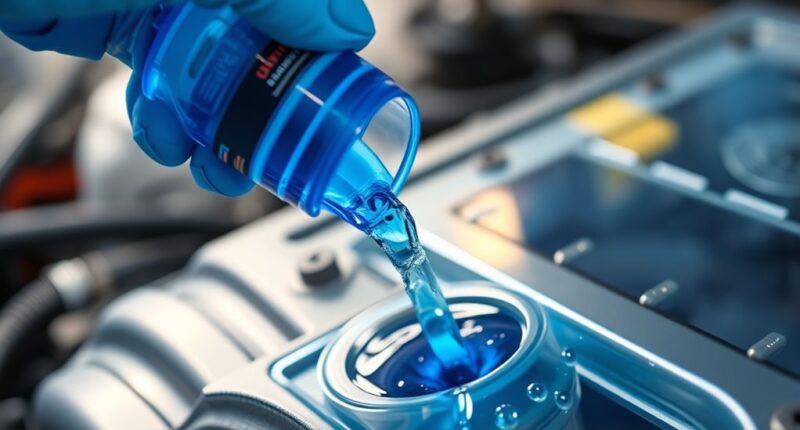To achieve perfect coolant bleeding without air pockets, start with a cool engine and locate the highest bleed point. Keep the system properly filled and verify the pressure cap is in good condition. Run the engine at idle with the heater on high, opening the bleed valve or screw to release trapped air until a steady, bubble-free stream appears. Maintain pressure and coolant levels. For more tips, you’ll discover additional proven techniques to keep your cooling system air-free and functioning smoothly.
Key Takeaways
- Always operate the engine at idle with the heater on maximum to facilitate complete coolant circulation and air removal.
- Open the bleed valve slowly, observing for a steady, bubble-free flow before closing to ensure all trapped air is expelled.
- Maintain proper system pressure using a functioning pressure cap to prevent air ingress during the bleeding process.
- Use a vacuum or manual pump to draw out air more efficiently, especially in complex or hard-to-reach cooling systems.
- Continue running the engine after bleeding and check coolant levels to confirm no residual air pockets remain.

Getting rid of air pockets in your cooling system is vital for ideal performance, but it can be tricky without the right techniques. To achieve a perfect coolant bleed without trapping air, you need to master effective bleeding techniques and focus on air pocket prevention. The goal is to guarantee coolant circulates freely, providing maximum heat transfer and preventing overheating.
Start by preparing your vehicle or system properly. Make sure the engine is cool before you begin, so you avoid hot coolant splashes. Locate the bleed valve or screw, which is usually positioned at the highest point of the cooling system. This is where you’ll release trapped air. Before opening it, fill the radiator or reservoir to the recommended level, guaranteeing there’s enough coolant to push out air pockets when you start the bleeding process. Keep a clean cloth handy in case of spills.
Begin by ensuring the engine is cool and filling the system before locating and opening the bleed valve at the highest point.
When bleeding, keep the engine running at idle and turn on the heater to maximum heat. This step allows the thermostat to open, ensuring coolant flows through the entire system, including the heater core. As the engine warms up, you’ll notice the coolant level dropping slightly; top it off as needed to maintain proper fill levels. Opening the bleed valve during this process helps release air pockets as they escape with the coolant. Always keep an eye on the coolant level to prevent air from being drawn back into the system. Additionally, using advanced machine learning algorithms in modern vehicles can optimize the cooling system’s efficiency, making bleeding easier and more effective.
A vital part of air pocket prevention is maintaining proper pressure. Many modern systems are pressurized, so ensure the pressure cap is in good condition and properly sealed. If you pressurize the system correctly, it reduces the likelihood of air ingress and makes bleeding easier. Some vehicles benefit from a manual pump or vacuum kit, which can pull air out more efficiently than just relying on gravity and pressure.
Once you see a steady, bubble-free stream of coolant from the bleed valve, close it securely. Continue to run the engine and check for any signs of air pockets, such as fluctuations in coolant level or overheating. Repeat the bleeding process if necessary, especially after topping off coolant or after system maintenance. Consistently practicing these bleeding techniques and focusing on air pocket prevention helps you achieve a system free of air pockets, ensuring your engine runs smoothly and stays cool.
Frequently Asked Questions
Can Coolant Bleeding Be Done Without Special Tools?
You can perform coolant bleeding without special tools by using simple DIY techniques. Start by running the engine with the radiator cap off and the heater on high, which helps air escape naturally. Keep an eye on the coolant level, topping it up as needed. While some necessary tools like a funnel can make the process smoother, many basic techniques don’t require specialized equipment, making it accessible for most DIYers.
How Long Should Coolant Bleeding Take?
Ever wonder how long coolant bleeding should take? It’s a critical process where you watch for steady coolant flow, signaling that air entrapment has been cleared. Typically, it takes about 10-20 minutes, but be patient—sometimes air pockets stubbornly cling, prolonging the process. Keep an eye on the temperature gauge and coolant level, ensuring smooth circulation. Rushing can leave air pockets behind, risking overheating. Stay vigilant, and the job’s done right.
Is It Necessary to Warm the Engine During Bleeding?
During bleeding procedures, warming the engine isn’t always necessary, but it can help. When the engine reaches ideal temperature, the coolant expands, making it easier to identify air pockets and guarantee proper circulation. However, if you’re just starting the process, you can often bleed coolant with the engine cool or slightly warm. Always follow your vehicle’s specific instructions to avoid overheating or damaging components during the bleeding process.
Can Incorrect Coolant Levels Cause Air Pockets?
Incorrect coolant levels can definitely cause air pockets in your cooling system. If the coolant level is too low, air can get trapped, leading to air pockets that hinder proper cooling. Always check and maintain the right coolant levels to prevent air pockets from forming. Proper coolant levels guarantee a smooth flow, reducing the risk of overheating and keeping your engine running efficiently.
What Are Signs of Incomplete Coolant Bleeding?
You’ll notice signs of incomplete coolant bleeding if you see persistent air bubbles in the coolant or if the coolant level keeps dropping. These air pockets prevent proper circulation, causing your engine to overheat or run inefficiently. Keep an eye on the coolant level and watch for air bubbles in the reservoir or radiator. Addressing these issues promptly guarantees your cooling system functions correctly and helps prevent damage.
Conclusion
Now that you know these pro secrets, you’ll have your cooling system running smoother than a racing car on a track. Proper bleeding eliminates pesky air pockets, preventing overheating and engine damage. Just follow these simple steps, stay patient, and watch your coolant flow perfectly without a single bubble in sight. It’s like commanding your cooling system to perform a flawless ballet — a feat that even the most advanced machines would envy. Keep at it, and enjoy the ultimate cooling mastery!










